Currant leaves - a gift of nature, with a wide range of beneficial properties for the internal health of the body and external beauty. This is an affordable raw material for the preparation of therapeutic infusions and decoctions, culinary preparations and cosmetics. The beneficial properties of black currant leaves are recognized by official medicine, and the extracts are used by beauty concerns for the preparation of expensive care products.
Table of contents
Useful properties of currant leaves and contraindications
Useful properties of each product for the human body are determined by the predominant in their composition of substances, a combination of vitamins and macronutrients.
During flowering shrubs in the leaves of the currant accumulates a record amount of vitamin C (260 mg%). This is 1.5-2 times more than in the fruits of the culture, which is achieved due to the low content of enzymes that destroy ascorbic acid. Vitamin C contained in 100 g of the product significantly exceeds the daily requirement of the human body (90 mg).
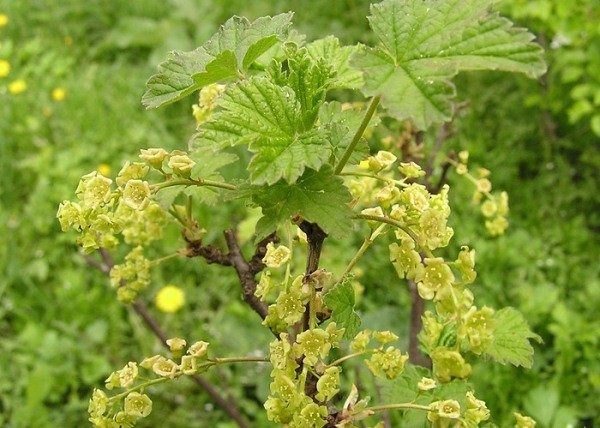
Without the participation of vitamin C, the formation of collagen and connective tissue is impossible. It provides bone and dental density, elasticity and firmness of the skin. Therefore, the external beauty of our body is partially dependent on vitamin C.
Organic compound regulates the process of blood clotting, reduces the permeability of the vascular walls and suppresses the development of inflammatory processes. These properties are excellent for the prevention and adjuvant treatment of atherosclerosis, hypertension,vascular pathologies and viral diseases.
Vitamin C is not synthesized in the body, so it should be stable with food. The organic compound is easily destroyed by mechanical damage and improper heat treatment. Therefore, fresh currant leaves are used whole and put only in boiling water.
The leaves of currant differ in the content of polyphenolic compounds that are significant for the human body:
- flavonols 2700 mg%;
- free catechins 941 mg%;
- condensed catechins 4414 mg%;
- proanthocyanidins 2174 mg%;
- bioflavonoids 7365 mg%.
These are strong natural antioxidants that inhibit the development of free radicals, unstable oxygen molecules that oxidize and destroy healthy cells. Excessive formation of free radicals violates all biochemical processes in the body., contributes to the malignant transformation of connective tissue. Therefore, currant leaves are useful for the diet of people after the treatment of oncological diseases or with a hereditary predisposition to them.
The use of currant leaves is indisputable for people who smoke,living in areas with a predominance of radiation background and in cities with polluted air. Natural antioxidants resist toxic substances and contribute to their removal from the body.
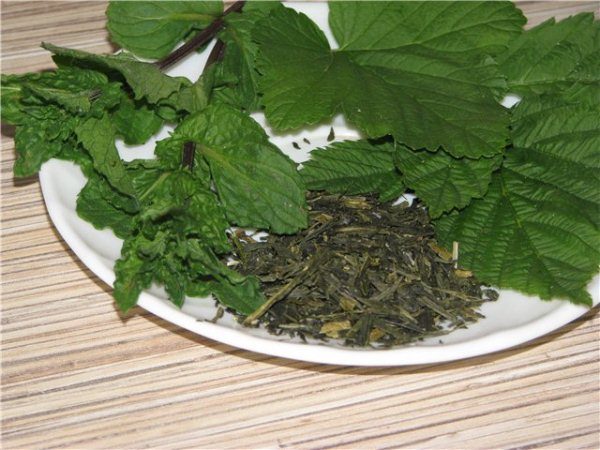
Currant leaves contain an impressive amount of basic macronutrients:
- magnesium 370 mg%;
- calcium 327 mg%;
- potassium 178 mg%;
- phosphorus 7.5 mg%;
- sodium 2 mg%.
These minerals are responsible for the strength and growth of bones, the health of muscle mass and the motor function of the body.
The predominance of magnesium and potassium in the leaves of the currant are especially useful for the work of the heart and the prevention of the appearance of a heart attack. These macronutrients strengthen the myocardium (heart muscle), regulate blood flow and restore heart rhythm.
Contraindication to the use of currants in any form is thrombophlebitis. It is impossible to abuse the leaves of black currant, because of them may increase blood clotting.
You can not take a decoction based on the leaves of black currant, if increased gastric acidity, with peptic ulcer disease, inflammation in the duodenum.In large quantities, drugs can not be taken during pregnancy., breastfeeding, they lead to side effects, various allergic reactions.
The use of leaves of black and red currants
Currant leaves can be applied all year round. Due to phytoncides in their composition, the useful substances of the plant are preserved practically in their natural form during drying and freezing.
Broths and infusions - the benefits and harm
In addition to the undoubted healing properties of decoctions and infusions of currant leaves have a wonderful aroma.
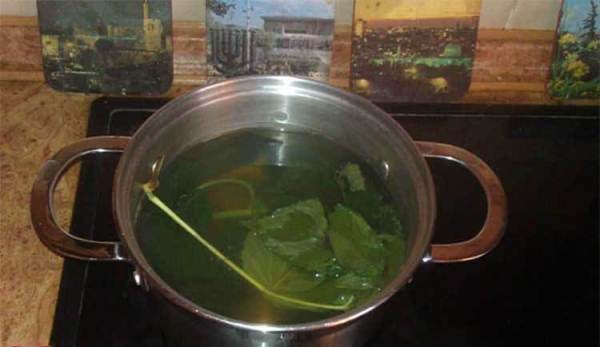
With systemic and proper use, they have a high therapeutic effect during prevention and treatment:
- bronchopulmonary diseases;
- inflammatory and catarrhal pathologies;
- hypertension;
- cardiovascular diseases;
- atherosclerosis;
- dysentery;
- diabetes.
The plant component strengthens the immune system, visual functions, regulates the work of the liver and kidneys. Decoctions and infusions are used for daily cleansing of the skin, make lotions on problem areas. Such procedures suppress inflammation in the skin cells, a common cause of acne and systemic sepsis of the face.
Healing baths
Anti-inflammatory properties of currant leaves greatly facilitate the manifestation of dermatitis and other skin diseases.
With the help of baths of currant leaves are treated:
- all types of dermatitis;
- prickly heat in children;
- diathesis;
- radiculitis.
The currant leaf bath is a great way to energize skin, nail and hair cells. This is a good alternative for many spa treatments for women.
Useful tea
Currant leaf tea is a good supplement to your daily diet.. The drink has tonic and tonic properties. This is a worthy replacement for more aggressive tea and coffee drinks.
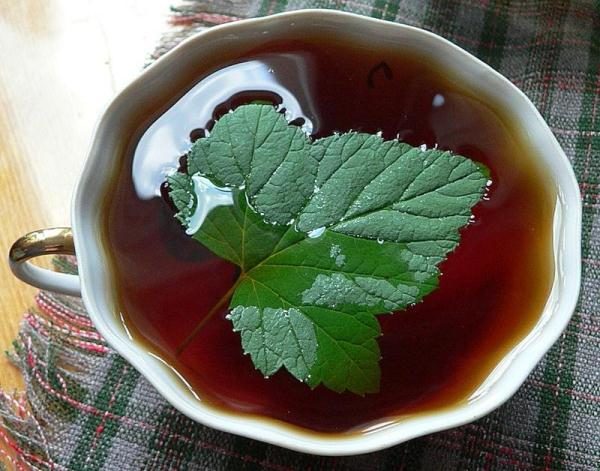
The diuretic properties of tea complement the complex treatment:
- renal pathologies (cystitis, pyelonephritis)
- urolithiasis;
- gout (uric acid excretion);
- swelling.
Especially useful tea for older people. At this time in the body there are significant metabolic disorders, blood circulation and the nervous system. The structures of the heart wear out and require increased support from the nutrients from food.
Medicinal and Cosmetic Recipes
Treatment with leaves of currant practiced for a long time, in addition there is a constant study of the beneficial properties of the plant component. Therefore today we can use the best recipes of medicinal and cosmetic products from currant leaves.
Popular recipes:
- Decoction. For the preparation of a remedy, dry and chopped leaves (4 tbsp. L) are placed in boiling water (1 l) and kept in a water bath for 30 minutes. Filter and cool. Take 200 ml 3 times a day.
- Infusion. Dry raw materials (5 tbsp. L.) Fall asleep in a thermos and pour boiling water (1 l). Insist 2-3 hours, filter and cool. Take 100 ml 3-4 times a day.With the help of this make lotions during inflammation of acne. To this end, a piece of gauze is moistened in a medical device and applied to problem areas for 15 minutes.
- Therapeutic bath. To prepare the bath, you can use and branches of the plant. To do this, 1 kg of raw material is poured with 10 liters of water and boiled for 30 minutes. After that, cover the dishes with a lid and insist 1 hour, filter and add to the bath. The duration of the procedure is 25 minutes, the recommended frequency is 2 times a week.
- Tea. In the summer it is better to brew tea from fresh leaves of currant or raspberry. To do this, the leaves (5-6 pieces) are put in boiling water (250 ml), hold 1 minute on the fire and leave for 2-3 minutes. To improve the taste, add a spoonful of honey. Tea can be brewed with the addition of mint, in which case you get a good sedative that promotes healthy sleep.
- Antiseptic compress. The medical procedure is recommended for owners of oily skin prone to the formation of acne. Dried leaves of currant (20 g), chamomile flowers (30 g), sea buckthorn fruits (50 g) are poured with boiling water (1 l) and exposed to a water bath for 20 minutes. Cool and filter. The gauze fabric moistened in broth is applied to the face for 10-15 minutes.The recommended course of treatment is 5 days.
- Mask for the face. Crushed fresh leaves (6 pcs.) And yogurt (150 ml) are thoroughly mixed and squeezed through gauze fabric. The nutrient mixture is applied to the face and incubated for 20 minutes. In winter, as a component, you can use the infusion of dry raw materials. The mask brightens pigments, evens the complexion, has a softening effect.
Collection and storage
Currant leaves will be useful only if properly prepared. Collect leaves during the flowering of currants, when the content of vitamins and macronutrients reaches a maximum. The collection is carried out with a minimum ambient humidity..
To do this, choose a day without precipitation, the period between 10-12 hours, when the morning dew dries out. Cut off the whole leaves of young shoots without signs of disease. Dried on the surface of the fabric in a dry and ventilated area without access to sunlight.
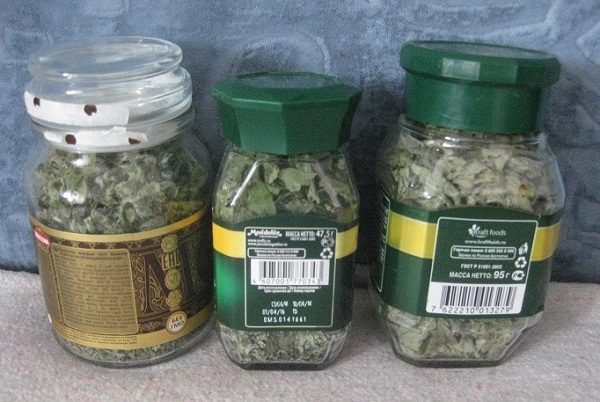
Store the product in tight fabric bags or glass jars, closed with a lid. Useful properties of raw materials are maintained for 2-3 years..
Despite the enormous potential of healing and beneficial properties for the human body, currant leaves unfairly pushed to the side. This can be explained by the easy availability of raw materials and the lack of complete information about the amazing plant component. Therefore, it is important to look at the modest plants around us, the names of which are often mentioned in the composition of expensive creams and medicines.

My grandmother loves currant tea